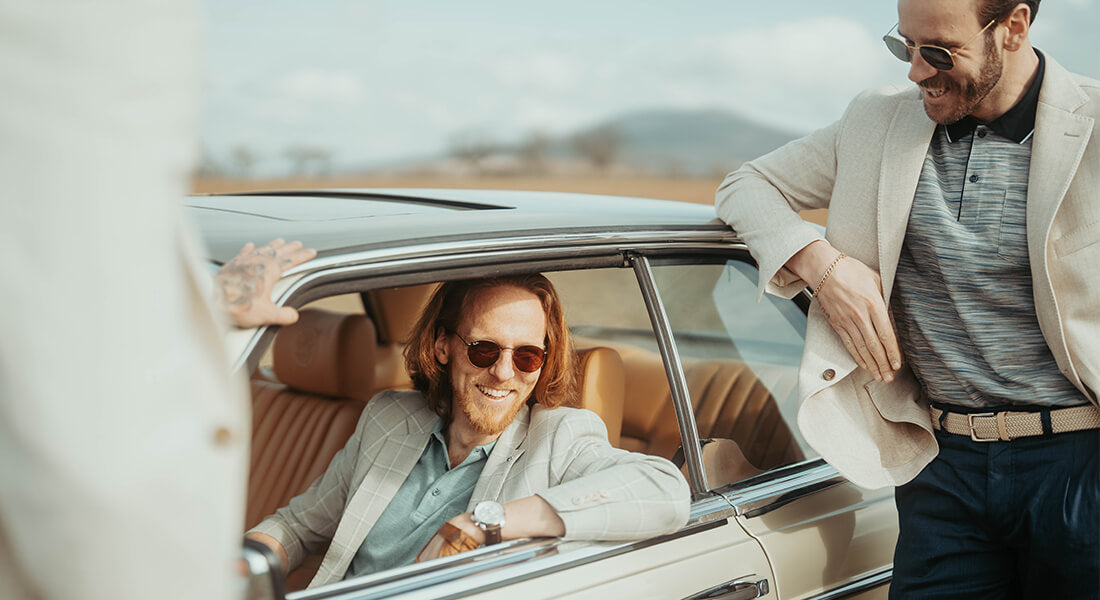Wedding trends have evolved and changed over the years, and it is interesting to see how some of them gradually return repeatedly. Women's fashion has undergone quite a lot of changes over the past decades, and this has also affected the fashion for wedding dresses. In men's social fashion, the changes were less significant, and only concerned small details. All the more so when choosing (not only) social - wedding - clothing, we should focus on quality and a well-fitting cut . And even though social etiquette has increasingly relaxed rules, a wedding is still an event when etiquette has its justification. Take a look with us at the development of wedding fashion across the decades of the 20th century.
Early 20th century

At the turn of the 19th and 20th centuries, the art nouveau style prevailed, which led to a new and previously unconventional style in fashion. Corsets and large skirts with crinolines gradually disappeared from women's fashion, and the first blouses and skirts appeared in wardrobes. The emancipation of women was also evident in the form of masculine elements on women's clothing. Clothing in Slovakia was influenced mainly by Vienna and Budapest.

After the First World War, the change in dress was even more noticeable, as clothes became simpler and more comfortable. A typical feature of the fashion of the 1920s was the elongated waists on women's dresses. Characteristic were necklines in the front and back, strapless dresses, headbands over the forehead, high gloves, ruffles and hats covering the face. Grooms wore suits with a slightly accentuated waist, which gradually decreased to a more casual cut, jackets and tailcoats with patent leather. At village weddings, peasants also wore boots with their suits and a small hat on their heads. In Slovakia, the wedding clothes of brides and grooms often had elements of folk costumes, or they wore a folk costume with everything that goes with it. If the couple got married during the groom's military service, he wore a uniform.
Fashion until 1947
[caption id="attachment_10540" align="alignnone" width="1100"]

The wedding of the abdicated King Edward VIII and Wallis Simpson in 1937[/caption] In the 1930s, the waist moved a little higher again – on women's dresses and men's jackets. The successful fashion designer Gabrielle Bonheur "Coco" Chanel was also increasingly asserting herself in fashion, taking inspiration from men's cuts and creating comfortable women's leisure clothes from them. Thanks to her, "little black dresses" (dresses) are part of almost every woman's wardrobe. However, the war period contributed to the shortage of various things, which also affected fashion. For example, skirts were shortened precisely because of the lack of fabric. However, stockings were a sign of elegance and, according to etiquette, were not allowed to be missing on certain occasions. Therefore, women toned their legs to visually convince people that they were wearing them.

The transformation of the silhouette also affected other more formal wedding attire, such as the blazer and tailcoat, which have survived in almost unchanged form to this day.
Post-war fashion

The wedding of US President JF Kennedy to Jacqueline in 1953[/caption] Fashion after World War II was considerably richer. The breakthrough in the fashion world was caused in 1947 by the Dior brand (then headed by designer Christian Dior) and its New Look collection. Long dresses with pleated skirts emphasized femininity and also influenced women's wedding fashion. Men's suits - single-breasted and double-breasted - changed mainly in the material used and small details. The jacket was initially relatively long, often appearing several sizes too large on the groom, the shoulders were still emphasized by padding. From the mid-1950s, jackets began to gradually narrow at the waist and become shorter, and the trousers also narrowed accordingly. Shoulder padding was less prominent, the shirt for formal occasions was still just white – complemented by subtle patterns and colors on accessories (ties, handkerchiefs). In addition to natural wool, synthetic materials began to be used for sewing suits, which are durable, easy to maintain and do not wrinkle.

Wedding fashion in Slovakia was still heavily influenced by folk culture. Wedding dresses were necklineless and had prominent collars. Brides and grooms often wore folk costumes.

Flower children and bells
[caption id="attachment_10543" align="alignnone" width="1100"]

The wedding of Princess Caroline of Monaco and Phillipe Junot in 1978[/caption] In the late 1960s, the hippie movement came to the fore, rejecting social conventions, which was also reflected in social clothing, which was somewhat more relaxed.

At that time, Czechoslovakia was ruled by socialism and clothes were in short supply. People bought fashionable clothes with vouchers in Tuzex, in East Germany, or had them made. Women drew inspiration from magazines such as Burda, Dorka, Praktická žena, and the like. Tailoring was a very popular profession at that time.
Years of eccentricity

The wedding of Prince Charles and Diana Spencer in 1981[/caption] The 1980s and early 1990s are usually considered less tasteful periods. Kitsch and extravagance were represented by large padding, strong makeup on women, long jackets, women's costumes, the inevitable "squeaks" and the so-called disco fashion. Some of these elements also appeared in wedding fashion. The most fashionable wedding dresses were with large "puff" sleeves or padding on the shoulders, wide "cake" skirts, ruffles and large hats. However, flowing dresses with petticoats decorated with lace and a pleated collar also appeared.

Today's wedding fashion is variable, and clothing adapts to the overall style of the wedding that the couple chooses. Our tips for men on how to dress for their own wedding can be found here .
Find more articles from the Wedding category here . Take advantage of our promotion and buy a wedding suit in our stores or in the e-shop from 299 euros. You can now buy selected suits with a discount of up to 40%. Stop by and we will choose a complete outfit with you, including a shirt, shoes, belt and other accessories.



